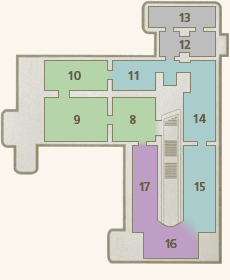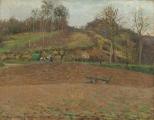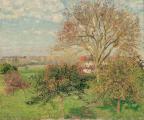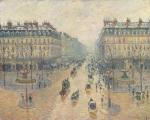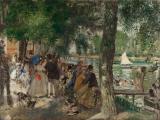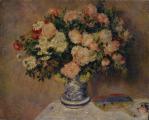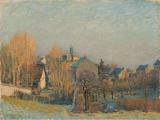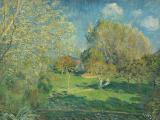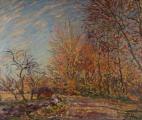In the painting of the Impressionists, who insisted on the need to work in the open air, the leading genre was the landscape. The oeuvre of Camille Pissarro and Alfred Sisley was based on the portrayal of nature as a treacherous dynamic element. In their canvases showing simple everyday subjects the main thing is not the choice of subject, but the careful observation of light and air effects which transform the familiar forms and colours of objects. Renouncing precise contours and drawing, these artists began to paint in small, separate brushstrokes which enabled them to create very complex colour modulations on the canvas.
The English painter Alfred Sisley spent most of his life in France. Accepting the ne w Impressionist concept of painting totally, Sisley combined it with a lyrical perception of the world. The subdued countryside of the He de France inspired the artist to produce many pictures which are remarkably intimate in tone and mood.
A somewhat different facet of the Impressionist landscape is found in the work of Camille Pissarro, the only permanent participant in all the group's exhibitions. Among the Impressionists Pissarro was regarded as the most “peasant-like” because of his desire to depict the countryside with its fields and vegetable patches, gardens and huts. Continuing the tradition of Jean- François is Millet, he saw the peasant's work as an integral part of the life of nature. Immediacy of observation is invariably combined in Pisarro with precisely elaborated compositional-spatial treatment.
The artistic tasks tackled by Monet, Pissarro and Sisley in the landscape are brilliantly embodied by Pierre-Auguste Renoir in his multi-figured genre compositions. He paints the busy Paris streets and reproduces the carefree atmosphere of cafes and picnics in the country. "I think a picture should be nice and pretty, yes,pretty ... There are quite enough unpleasant things in this life already, without us increasing their number," the artist liked to say. In the free, unconstrained manner typical of Impressionism, Renoir depicts apparently random situations. Leaving out the boring details, the artist seeks to turn what he has seen into a pictorial spectacle of chiaroscuro and colour reflexes. He rejects traditional modelling of form and clear contours, replacing them with subtle scumbling and small quick brushstrokes, thereby achieving a remarkable sense of how rich and precious painting can be.


